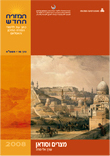Outward Appearance, Personal Care and Sexuality in Early Muslim Sources
Hadas Hirsch
Islam is a law-based religion that prescribes proper behavior of believers in all areas of life. Differentiating between male and female socially as well as biologically, Muslim societies, on the whole, are strongly gendered societies. Thus, analyzing textual findings from a gender perspective enables one to reveal the nature of relations between sexuality, gender and outward appearance, and to demonstrate, in particular, how a patriarchal society reinforces this differentiation between male and female by means of their outward appearance.
Medieval Muslim legal sources, written by and collected by authors of different law schools and which represent a wide geographical and chronological range deal with various aspects of outward appearance. The Compendiums of furu` al-fiqh and fatawa should be seen as the product of a continuing, two-way dialogue between law and reality, and as reflecting the desired norms side by side with existing customs.
These sources deal with various rules of outward appearance and aesthetics, including personal care and hygiene, some of which are associated with the laws of purity and impurity. Physical variables, such as clothing and adornment are perceived primarily as proof of God’s grace towards mankind and both sexes are ordered to take care of their outward appearance although the legal explanations for each sex are different.
Women were allowed to adorn themselves for sexual attraction albeit under supervision so as to prevent seduction and infringement of the patriarchal structure. Men were allowed to adorn themselves for various other reasons, such as to declare their socio-economic status, to demonstrate the greatness of God and, of course, to attract the attention of women but not to seduce.


